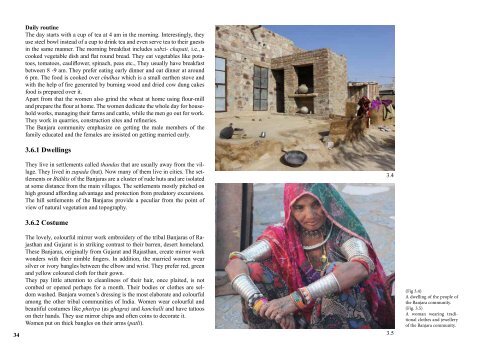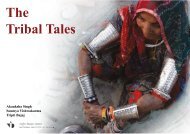Create successful ePaper yourself
Turn your PDF publications into a flip-book with our unique Google optimized e-Paper software.
Daily routine<br />
<strong>The</strong> day starts with a cup of tea at 4 am in the morning. Interestingly, they<br />
use steel bowl instead of a cup to drink tea and even serve tea to their guests<br />
in the same manner. <strong>The</strong> morning breakfast includes sabzi- chapati, i.e., a<br />
cooked vegetable dish and flat round bread. <strong>The</strong>y eat vegetables like potatoes,<br />
tomatoes, cauliflower, spinach, peas etc., <strong>The</strong>y usually have breakfast<br />
between 8 -9 am. <strong>The</strong>y prefer eating early dinner and eat dinner at around<br />
6 pm. <strong>The</strong> food is cooked over chulhas which is a small earthen stove and<br />
with the help of fire generated by burning wood and dried cow dung cakes<br />
food is prepared over it.<br />
Apart from that the women also grind the wheat at home using flour-mill<br />
and prepare the flour at home. <strong>The</strong> women dedicate the whole day for household<br />
works, managing their farms and cattle, while the men go out for work.<br />
<strong>The</strong>y work in quarries, construction sites and refineries.<br />
<strong>The</strong> Banjara community emphasize on getting the male members of the<br />
family educated and the females are insisted on getting married early.<br />
3.6.1 Dwellings<br />
<strong>The</strong>y live in settlements called thandas that are usually away from the village.<br />
<strong>The</strong>y lived in zupada (hut). Now many of them live in cities. <strong>The</strong> settlements<br />
or Bidikis of the Banjaras are a cluster of rude huts and are isolated<br />
at some distance from the main villages. <strong>The</strong> settlements mostly pitched on<br />
high ground affording advantage and protection from predatory excursions.<br />
<strong>The</strong> hill settlements of the Banjaras provide a peculiar from the point of<br />
view of natural vegetation and topography.<br />
3.4<br />
3.6.2 Costume<br />
34<br />
<strong>The</strong> lovely, colourful mirror work embroidery of the tribal Banjaras of Rajasthan<br />
and Gujarat is in striking contrast to their barren, desert homeland.<br />
<strong>The</strong>se Banjaras, originally from Gujarat and Rajasthan, create mirror work<br />
wonders with their nimble fingers. In addition, the married women wear<br />
silver or ivory bangles between the elbow and wrist. <strong>The</strong>y prefer red, green<br />
and yellow coloured cloth for their gown.<br />
<strong>The</strong>y pay little attention to cleanliness of their hair, once plaited, is not<br />
combed or opened perhaps for a month. <strong>The</strong>ir bodies or clothes are seldom<br />
washed. Banjara women’s dressing is the most elaborate and colourful<br />
among the other tribal communities of India. Women wear colourful and<br />
beautiful costumes like phetiya (as ghagra) and kanchalli and have tattoos<br />
on their hands. <strong>The</strong>y use mirror chips and often coins to decorate it.<br />
Women put on thick bangles on their arms (patli).<br />
3.5<br />
(Fig 3.4)<br />
A dwelling of the people of<br />
the Banjara community.<br />
(Fig. 3.5)<br />
A woman wearing traditional<br />
clothes and jewellery<br />
of the Banjara community.




